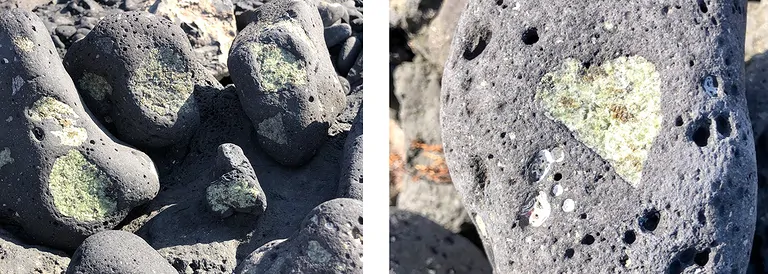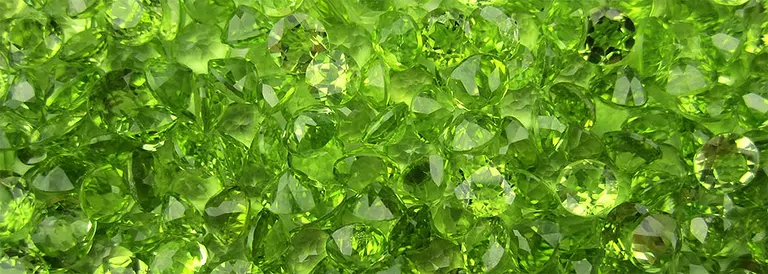
Peridote (Olivine) - Meaning, effect and application
The green Peridote supports to break free from external determination and to live one's life According to their own wishes and ideas to live. The gemstone encourages to recognize omissions, to admit mistakes and defaults and to forgive ourselves, so that - possibly after a course correction - one can continue to work powerfully on the fulfillment of plans and dreams. From the wealth of experiences one has had so far, it's possible to gain understanding and wisdom.
You have to kiss a lot of frogs,
before you find a prince. It is similar with the Peridote: Olivine is abundant on the earth and in many places in the world, Peridote is clearly rarer to find. The difference between Peridote and Olivine lies primarily in the purity and thus the color and transparency of the pieces. In retail as well as in the wholesale with Olivine mostly the fine-grained, unprocessed mineral is designated. Peridote characterizes purer pieces, where cutting and faceting is worthwhile, as well as worked, often faceted gemstones. While Olivine occurs in chunks up to the size of a fist, the purer Peridote is found only in small crystals of a few centimeters. Therefore, the Olivine is mainly found as Tumbled Stone, drilled stone piece or Donut in the trade, while the Peridote as a cut, faceted gemstone as a chain, ring or pendant stone is is used.
Peridote jewelry at wholesale prices

Mineralogical profile of Peridote / Olivine
Chemical Formula: (Mg,Fe)2(SiO4) +. Al,Ca,Mn,Ni,Co,Cr,Ti,Pt
Mineral Class: Magnesium-iron mineral
Color: olive green, bottle green, yellow green, moss green, brown green. Peridote occurs exclusively in various shades of green. The coloring metals are iron, nickel and chromium.
Gloss: glassy
Crystal system: rhombic
Mohs hardness: 6.5 to 7
Cleavability: imperfect, Fracture: brittle, small-muscled
Formation: primary-liquid magmatic during crystallization from basic and ultrabasic magmas. or by hydrothermal reforming in seafloor cavities, rarely in iron-nickel meteorites.
Mainly from Russia, meteorites containing larger amounts of Olivine are also known. These extra-terrestrially formed olivine crystals in a nickel-iron matrix are called Pallasite designated.
Localities: Egypt (Zebirget Island), Australia, Brazil, Germany, China, CIS, Italy, Canada, Myanmar, Mexico, Norway, Austria, Pakistan, Spain (Lanzarote), South Africa, USA (Arizona).
The highest-grade Peridote deposits are located on the Egyptian volcanic island of Zebirget in the Red Sea, east of Aswan. One of the largest cut Peridote in the world also comes from there, weighing 310 carats (62 g) and can be viewed at the Smithsonian Museum in Washington.
The rough material for cutting of faceted stones today comes mostly from northern China or Korea; very fascinating are also the finding areas at the black lava beaches on Lanzarote; there larger rough pieces of Olivine, so-called Olivine bombs, can be found.
For bead stringing people and other professionals: peridote at wholesale prices

Origin of the name Peridote and synonyms
In gemstone healing, the name chrysolite is also commonly used for Peridote and Olivine.
In ancient Rome, the Peridote was also called "Evening Emerald" because the stone, thanks to its transparency can be easily illuminated by the light of a lamp or lantern.
Other synonyms, hardly found in wholesale today, are hyalosiderite, talassakite and sideroskelpt.
Historical facts about Peridote
Peridote is mentioned in the Bible (here under the name Chrysolite) in several places. Thus it e.g. a stone in the breast shield of Aaron, the brother Moses, to have been. In the revelation of John it belongs to the twelve precious stones, from which the foundation walls of the heavenly Jerusalem are to consist. In the Middle Ages the Peridote much for religious decoration used and in the baroque time he was the favorite stone of the Epoch.
Peridote jewelry at wholesale prices
Usage of Peridote in gemstone healing
In gemstone healing, Peridote and Olivine are often used as an "anti-annoyance stone" when everyday life is Is characterized by negative aspects. The fresh green of the Peridote affects us like a walk in the Wonnemonat May. Melancholy and gloomy thoughts dissolve, vigor and initiative gain through the support of the magmatic mineral Peridote the upper hand. New beginnings are facilitated by the olive-green gemstone. facilitated, old and burdensome can be better left behind. Peridote conveys joy, tolerance and composure, it helps with hurt feelings and clears up with self-reproaches and Guilt reproaches on. Hildegard von Bingen speaks in this context of the "purification of the heart", which the Qualities of the Peridote particularly beautifully describes.
In the chakra system, the Peridote is assigned to the heart chakra, and according to astrological observation, it fits particularly well to Gemini and Leo.
As a water Stone, Peridote encourages living one's life and gaining wisdom through life experience. Mistakes and failures can be recognized, but also forgiven. Peridote is part of the Gemstone Balance water stone mixture "Fountain of Youth" as well as various VitaJuwel products.
Peridote in the books of Hildegard of Bingen
The wise, gemstone-knowledgeable nun Hildegard von Bingen (1098 - 1179) wrote about the chrysolite: "The Chrysolite arises from the sun's glow and the humidity of the air after midday around the ninth hour of the day and has a kind of life-giving strength in itself. [...] The same stone consolidates also the knowledge in the person who carries it with him, so that the one who has good knowledge and skills should put the stone to his heart, and as long as it remains there, knowledge and skills will not leave him. depart. [...] Then it expels the bad juices that plunge the heart of man into sorrow, and purifies the heart of that person."
Text courtesy of Verlag Neue Erde from: Michael Gienger: Die Heilsteine der Hildegard von Bingen (The Healing Stones of Hildegard of Bingen).